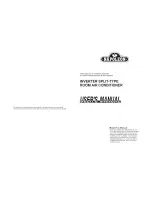
20
INStALLAtION
1
Gas pipe
2
Condensation discharge
3
Liquid pipe
4
Heat insulation
5
Adhesive tape
5
4
4
1
2
3
—
insulate the liquid and gas pipes separately
—
use insulating material that is thicker than 15 mm
—
ensure that the insulating material adheres to the pipe wi-
thout gaps
—
fix using adhesive tape
9
Do not tighten the adhesive tape too much, so as to avoid
damaging the insulation.
9
Avoid partial insulation of the pipes.
9
In case of use with outdoor temperature above 30 °C and
relative humidity above 80%, increase wall thickness up to
20 mm.
For gas pipes:
—
ensure that the material used resists to temperatures up
to 120°C
For liquid pipes:
—
ensure that the material used resists to temperatures up
to 70°C
Stop valves
Cooling connections feature shut-off valves.
During operations on the cooling circuit, start-up and service, it
may be required to open and close the valves.
A
Opening
B
Closing
1
Service connection blanking plug
2
On-off valve shaft
3
Refrigerating pipe attachment
4
On-off valve cover plug
5
Hex wrench
1
2
3
4
5
A
B
If required:
—
remove the valve covering plug
—
operate on the valve shaft with an hex wrench
—
open or close according to what is needed
—
immediately stop as soon as the valve shaft has reached
the stop point
—
use a torque wrench calibrated on the valve diameter
Pipe Ø
Hex
wrench
Valve
tightening
torque
Plug
tightening
torque
mm
inches
mm
Nm
Nm
6,35
1/4
5
6
25
9,52
3/8
5
6
25
12,70
1/2
5
8
30
15,88
5/8
5
10
35
9
Do not force beyond the stop point to prevent damaging the
shaft and causing leakage as a consequence.
At the end of the operations:
—
refit the valve covering plug
9
Carefully check for absence of leakages from the closing
point of the plug.
Circuit tightness check
The appliance is tested at the factory and the indoor refrigera-
ting circuit tightness does not usually need to be checked.
The refrigerating circuit built on site needs to be checked inste-
ad.
to check tightness:
—
keep the outdoor unit shut-off valves closed













































